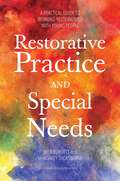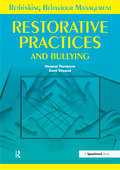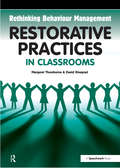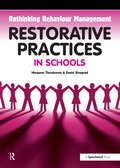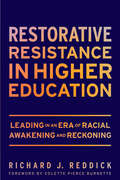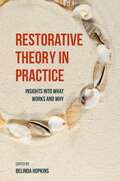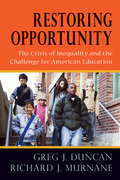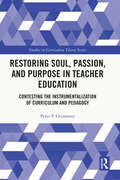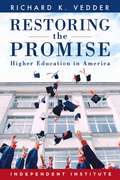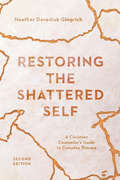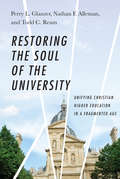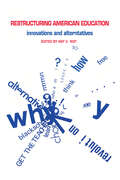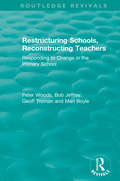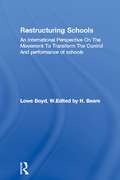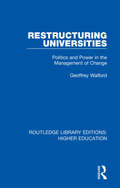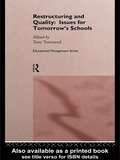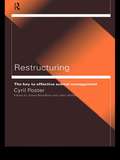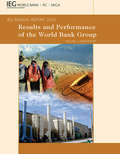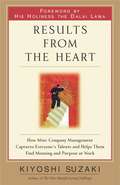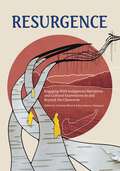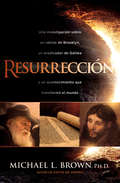- Table View
- List View
Restorative Practice and Special Needs: A Practical Guide to Working Restoratively with Young People
by Margaret Thorsborne Nicholas Burnett Nancy RiestenbergRestorative Practice (RP) is an effective approach to discipline that has the potential to transform behaviour by focusing on building and restoring relationships. This practical guide explains how to implement restorative approaches with young people with special needs in educational or residential settings. The book explores how RP is being used in general terms and through a number of case studies looks at how RP needs to be adapted for those with additional needs including Autism Spectrum Disorder, ADHD, Foetal Alcohol Spectrum Disorder, Intellectual Disability and communication difficulties. It includes guidance on particular issues such as staff facing crises, the issue of physical restraint and additional support parents require. The book will be of interest to restorative practitioners, educational professionals including headteachers, teachers and SENCOs in both special education and mainstream schools and residential care leaders and staff.
Restorative Practices and Bullying
by Margaret ThorsborneThis book focuses on the needs of the community affected by bullying behaviour, rather than simply apportioning blame and deciding on punishment. It covers topics including: restorative justice and bullying; restorative responses to bullying incidents; and managing reluctance to face up to bullying.
Restorative Practices in Classrooms: Insights Into What Works And Why
by Belinda HopkinsThis work helps in rethinking behaviour management through the use of restorative justice methods in the classroom. This clearly presented manual takes practitioners in gradual stages through the harsh realities of confronting wrong-doing and injustice in school. The traditional approach seeks simply to apportion blame and punish the wrongdoer. There is now strong evidence that restorative justice can be effective in reducing problem behaviour, and in engendering a sense of fairness and justice among all stakeholders in the school community. The book provides: an explanation of restorative justice and behaviour management; a wide range of restorative practice measures; step-by-step instructions for planning and facilitating individual, small group and whole class conferences; frequently asked questions and answers; key master documents that can be adapted; and, case studies. It is full of practical suggestions and techniques for dealing with problem behaviour, whether trivial or serious. It is suitable for ages 7-16.
Restorative Practices in Schools: Rethinking Behaviour Management
by Margaret ThorsborneThis work helps in rethinking behaviour management in the whole school through the use of restorative justice methods. School conferences have proved remarkably successful in teaching students about their responsibilities and accountability to other people. This manual fulfils an important role by outlining the techniques to learn and apply when planning and facilitating conferences. It includes guidance on: analysing current school practice; deciding whether to hold a conference; preparing a conference; convening and facilitating a conference; and, follow-up after a conference. The book contains many key documents such as preparation checklist, conference script, typical agreement, evaluation sheet and case studies. It is suitable for ages 8-16.
Restorative Resistance in Higher Education: Leading in an Era of Racial Awakening and Reckoning
by Richard J. ReddickAn affirming resource for leaders and practitioners forwarding diversity, equity, and inclusion efforts on campus. In Restorative Resistance in Higher Education, diversity researcher and educator Richard J. Reddick shares the wisdom gained from three decades of diversity, equity, and inclusion (DEI) work in educational settings. Reddick centers DEI efforts as challenging yet essential components of college life, recognizing campus environments not just as mirrors reflecting societal values and biases but also as crucibles for social change. Creating a more equitable college campus, Reddick argues, is a complex task that should be met by all members of the university community. He discusses many measures that promote wider involvement, including campus cultural orientations, professional development for faculty and staff, and frameworks to help institutional leaders respond to inequity and exclusion on campus. Delivering a trove of best practices for equity advancement, Reddick offers DEI professionals, and all members of the higher education community, the tools to engage in the work on professional, academic, and personal levels. He advocates developmental relationships such as mentoring, role modeling, and coaching as a means for historically marginalized students to access hidden educational pathways. He also encourages frank discussion of the social and emotional tax on persons who participate in or lead work on these highly charged issues. Throughout this crucial work, Reddick emphasizes the importance of restorative and sustaining approaches: those that promote practitioner well-being and challenge unjust structures.
Restorative Theory in Practice: Insights Into What Works and Why
by Pam Denicolo Dorothy Vaandering Margaret Thorsborne Mark Vander Vennan Mo Felton Shona Cameron Belinda Hopkins Wendy Drewery Ann Shearer Juliet Starbuck Pete WallisRestorative practice is an innovative approach to thinking about, and addressing, conflict and bullying, as well as disruptive, challenging and criminal behaviour. The approach is increasingly used to transform the culture of organisations, institutions and services and the way people communicate with one another. In this book, ten practitioners describe a restorative encounter as seen through the lens of their own theoretical model. The book's unique structure is modelled on a restorative practice known as Circle Time- comprising of a Check-in, a Main Activity, and a Check-out. In the Check-in the practitioner explains how their own theoretical model informs their practice; in the Main Activity they comment on the same case studies to highlight how each theory can deepen our understanding of what might be happening and why; and in the Check-out they reflect on what they have learned from reading each other's contributions. This is a unique exemplar of how restorative theory and practice can influence how practitioners think, learn and write about restorative practice. This will be an invaluable resource for restorative practitioners working across sectors including education, social services, youth offending or policy.
Restoring Classic And Collectible Cameras
by Thomas TomosyExpert advice for turning old cameras into valuable collectibles, these step-by-step instructions show how to restore a vintage camera. Learn to work on antique leather, brass, and wooden components to achieve a complete camera restoration.
Restoring Opportunity: The Crisis of Inequality and the Challenge for American Education
by Richard J. Murnane Greg J. DuncanIn this landmark volume, Greg J. Duncan and Richard J. Murnane lay out a meticulously researched case showing how--in a time of spiraling inequality--strategically targeted interventions and supports can help schools significantly improve the life chances of low-income children.A crowning contribution from two leading economists in the field of education, Restoring Opportunity is a passionate call to action on behalf of the young people on whom our nation's future depends. This book is a copublication with the Russell Sage Foundation."Duncan and Murnane provide a no-nonsense view of the growing educational gap between the haves and the have-nots in America. They also scour the landscape to find promising solutions that provide hope for better outcomes in the future. This is a thoughtful book that should be read with the care it merits."--Joel Klein, CEO of Amplify, and former chancellor, New York City Department of Education"This thorough examination of our public school system provides a clear picture of some of the toughest challenges--particularly those facing low-income students--and the directions in which we need to go to fix them. This book should be on the desk of every educator and policy maker in America so we can begin to change the odds for all of America's children."--Geoffrey Canada, president and CEO, Harlem Children's Zone"Anyone who cares about improving schools should read this book. Duncan and Murnane offer detailed case studies of effective programs to improve schools that can boost the life chances of disadvantaged children. The authors present a careful analysis, grounded in economics and education, of the ways to make better schooling available to all of the nation's low-income children."--David K. Cohen, John Dewey Collegiate Professor of Education and professor of public policy, University of Michigan
Restoring Opportunity: The Crisis of Inequality and the Challenge for American Education
by Richard J. Murnane Greg J. DuncanIn this landmark volume, Greg J. Duncan and Richard J. Murnane lay out a meticulously researched case showing how—in a time of spiraling inequality—strategically targeted interventions and supports can help schools significantly improve the life chances of low-income children. The authors offer a brilliant synthesis of recent research on inequality and its effects on families, children, and schools. They describe the interplay of social and economic factors that has made it increasingly hard for schools to counteract the effects of inequality and that has created a widening wedge between low- and high-income students.Restoring Opportunity provides detailed portraits of proven initiatives that are transforming the lives of low-income children from prekindergarten through high school. All of these programs are research-tested and have demonstrated sustained effectiveness over time and at significant scale. Together, they offer a powerful vision of what good instruction in effective schools can look like. The authors conclude by outlining the elements of a new agenda for education reform.Restoring Opportunity is a crowning contribution from these two leading economists in the field of education and a passionate call to action on behalf of the young people on whom our nation&’s future depends.Copublished with the Russell Sage Foundation
Restoring Soul, Passion, and Purpose in Teacher Education: Contesting the Instrumentalization of Curriculum and Pedagogy (Studies in Curriculum Theory Series)
by Peter P. GrimmettThis text both challenges and traces the development of a culture of regulation, standardization, performativity, and governmentality evident in Anglophone teaching practice and education. Framed by a brief history of teacher education research and policy in North America over the last six decades, the text argues that the instrumentalization of curriculum and pedagogy has robbed teachers of their pedagogical soul, passion, and purpose. Using a conceptual model, Grimmett forges a pathway for teachers to adopt a soulful way forward in professional practice, individually and collectively enhancing autonomy over programs, and protecting the public trust placed in them as educators. This text will benefit researchers, academics, and educators with an interest in teachers and teacher education, educational policy and politics, and curriculum thinking and enactment more broadly. Those specifically interested in pedagogy, educational change and reform, and the philosophy of education will also benefit from this book.
Restoring the Promise: Higher Education in America
by Richard K. VedderHigher education in America is in crisis. Costs are too high, learning is too little, and the payoff to students and society is increasingly problematic. In Restoring the Promise, Richard Vedder shows how the precarious position of colleges and universities results from a mostly unsuccessful expansion of governmental involvement in the academy, especially at the federal level.The book examines today&’s most serious issues in higher education, including free speech and academic freedom; tuition and other costs; culture and curricula; governance; gender, race and diversity; due process; admissions; student loans; and much more. It diagnoses problems and identifies solutions. For example, the total cost of college per student in the United States is now higher than in any other country. When combining the monetary costs of college with the opportunity costs of losing years of labor to the economy, the true cost of higher education to American society well exceeds one trillion dollars annually. Yet, despite American higher education&’s immense price tag, students are learning less than ever before and continue to be underemployed. The book discusses the three &“I&’s&” of university reform: information, incentives, and innovation. Without information, it is impossible for taxpayers and governing authorities to ensure that public education spending truly furthers the broader interests of society rather than the narrow interests of faculty and administrators. Shaping incentives for management would help to reduce costs and improve quality. Business practices such as Responsibility Centered Management (RCM), for example, allow profit to motivate efficiency and encourage learning outcomes. And expanding the use of innovation in technology and open online courses, along with relinquishing old rules such as tenure and three-month summer vacations, offer new hope for institutions of higher education. The book discusses such additional reforms as the following: Ending or revising the federal student financial aid program Giving departments or even professors a share of overall revenue based on student enrollments in their classes. Departments or professors would then be required to pay their share of travel, building rental, maintenance, utilities, and other such costs from the revenues they receive Providing earnings data on former students by college five, ten or fifteen years after matriculation. Prospective students (and parents) as well as lawmakers and oversight officials would be assisted regarding school successes and failures Increasing faculty teaching loads Instituting three-year degrees and year-round instruction Ending discrimination against for-profit schools Ending grade inflation Ending speech codes and other barriers to academic freedom Ending affirmative action and related diversity programs And more...
Restoring the Shattered Self: A Christian Counselor's Guide to Complex Trauma (Christian Association for Psychological Studies Books)
by Heather Davediuk GingrichNearly every professional counselor will encounter clients with a history of complex trauma.Restoring the Shattered SelfDSM-5
Restoring the Soul of the University: Unifying Christian Higher Education in a Fragmented Age
by Todd C. Ream Perry L. Glanzer Nathan F. AllemanChristianity Today's 2018 Book of the Year Award of Merit - Politics/Public Life Has the American university gained the whole world but lost its soul? In terms of money, prestige, power, and freedom, American universities appear to have gained the academic world. But at what cost? We live in the age of the fragmented multiversity that has no unifying soul or mission. The multiversity in a post-Christian culture is characterized instead by curricular division, the professionalization of the disciplines, the expansion of administration, the loss of community, and the idolization of athletics. The situation is not hopeless. According to Perry L. Glanzer, Nathan F. Alleman, and Todd C. Ream, Christian universities can recover their soul—but to do so will require reimagining excellence in a time of exile, placing the liberating arts before the liberal arts, and focusing on the worship, love, and knowledge of God as central to the university. Restoring the Soul of the University is a pioneering work that charts the history of the university and casts an inspiring vision for the future of higher education.
Restructuring American Education: Innovations and Alternatives
by Ray C. RistStructured schools, free schools, graded schools, ungraded schools, no schools at all—the conflicts over public education in America rage on, for contemporary schools have not lived up to our expectations. The essence of the criticism reflected in the essays in this volume is that America's dual educational goals—free inquiry and social mobility-are not being met. Instead of producing enlightened citizens capable of high social and economic mobility, our schools have become warehouses of children stored as commodities, docile and immobile.
Restructuring Schools, Reconstructing Teachers: Responding to Change in the Primary School (Routledge Revivals)
by Peter Woods Bob Jeffrey Mari Boyle Geoff TromanDrawing on wide ranging research this book, originally published in 1997, explores how the policy changes of previous years were affecting primary teachers and their work at the time. Within the context of worldwide restructuring, the thoughts, feelings and activities of teachers in their daily work are examined. The core argument is that what used to be a complex but fulfilling job distinguished by professional dilemmas, which are amenable to professional skill, had become increasingly marked by tension and constraint, which frustrates teacher creativity. While some teachers found new opportunities in the ‘new’ primary school, many used strategical and micro-political activity in order to cope, while others fell victim to stress and burnout. The authors argue that teachers’ own active involvement in policy change is required if their creative potential is to be realized. The book will still be of interest to teachers in primary schools, researchers and policy makers.
Restructuring Schools: An International Perspective On The Movement To Transform The Control And performance of schools
by W. Lowe BoydEducation reform has become part of a political imperative in a number of developed countries around the world. The simultaneous movement to reform schooling and the administrative structures which deliver educational services therefore needs to be studied in order to lay bare its fundamental assumptions. This movement has been labelled "restructuring" and "reform", although the words carry different meanings in different countries.; The authors question why this reconstruction occurred at the same time in different places. What common themes are emerging in the restructuring movement? And in the 1990s, where will the movement lead schooling and what essential changes will it effect? They explore these questions by examining developments in the USA, Canada, the UK, Australia, New Zealand and Japan.
Restructuring Universities: Politics and Power in the Management of Change (Routledge Library Editions: Higher Education #31)
by Geoffrey WalfordOriginally published in 1987 Restructuring Universities uses Aston University as a case study of the internal restructuring taking place in universities. Aston lost one third of its funding in 1981 and was told to reduce its student numbers by one fifth within three years. The university has a balanced financial budget, well oversubscribed courses, and the average A level scores of entrants are over the national average in all subjects taught. The books looks at the ways in which the university dealt with rapid change, looking particularly at the decision making processes within the university and the ways in which internal power and politics influenced decisions made. Previous models of decision making are discussed and a new political model outlined. The book provides a useful and informed analysis of the context, politics and management of change in the university system.
Restructuring and Quality: Issues for Tomorrow's Schools
by Tony TownsendThe restructuring of schools systems across the world has been controversial. Have reforms been driven by a desire to cut educational budgets or the need to improve the quality of educational provision? This book explores the restructuring movement, with a particular emphasis on how decentralisation of power has affected the quality of education. It provides a broad and international picture of educational reform.
Restructuring: The Key to Effective School Management (Education Management Ser.)
by Cyril PosterThis book provides an introduction to and analysis of the concept of the restructuring of schools. It includes detailed case-study material, which analyses the theory, considers the real people involved, and offers practical solutions to the problems of understanding and managing restructuring. Cyril Poster retired from teaching to become deputy director of the National Development Centre for School and Management Training at Bristol University, and then a freelance trainer and consultant. He was the previous series editor of the Routledge Educational Management series. Sonia Blandford is a member of the Oxford Centre for Education Management and Services, Oxford Brookes University. She is a consultant, author and lecturer. John Welton is currently Professor of Education, Oxford Brookes University. As a consultant, researcher and author he has worked extensively in Britain and overseas.
Results from the Heart
by Kiyoshi SuzakiResults from the Heart introduces a new and helpful approach to improving job performance, improving job satisfaction, and helping organizations better respond to the rapid changes that are an inherent part of today's business environment. Mr. Suzaki recognizes that a motivated and engaged workforce should be part of any strategy to obtain and maintain competitive advantage. --Carl Stern, CEO, The Boston Consulting Group Since the publication of Frederick Taylor's The Principles of Scientific Management, managers have relied on logic to compel action. Now Kiyoshi Suzaki, one of the world's leading experts on enlarging the talents, self-esteem, and growth of the individual employee, argues that logic alone cannot move people to act. Productivity problems are inextricably linked to self-esteem, he argues, and worst of all to a prodigious waste of individual talent. But each solution is personal, Suzaki concludes, and found only within ourselves. "To find meaning and purpose at work we must use our brain," Suzaki says, "but listen to our heart." In Zenlike fashion he proposes that each of us ask ourselves a series of questions to determine the degree to which our brain is engaged with our heart. The framework around which this selfquestioning takes place is a groundbreaking concept that Suzaki calls "the mini-company." The author demonstrates how, within the larger workplace, each job is endowed with an almost spiritual meaning when each person -- at every level -- becomes president of his or her own area of responsibility. With simple diagrams, Suzaki shows how your boss becomes your banker or venture capitalist and your peers become your immediate suppliers or customers. The results are nothing short of astonishing. In Results from the Heart, Suzaki describes thousands of mini-companies he has "founded" during his worldwide consulting assignments. In most cases in which unhappy employees had previously "followed instructions like robots," there have been spectacular increases in both morale and productivity. If it is true that work is a journey, this manifesto for a more humane definition of the way we work is the roadmap.
Resurgence: Engaging With Indigenous Narratives and Cultural Expressions In and Beyond the Classroom (The Footbridge)
by Rita Bouvier David A. Robertson Sara Florence Davidson Charlene Bearhead Wilson Bearhead Louise B. Halfe Lisa Boivin Nicola I. Campbell Wanda John-Kehewin KC Adams Sonya Ballantyne Lucy Hemphill Elizabeth LaPensee Victoria McIntosh Reanna Merasty Russell Wallace Christina Lavalley Ruddy★ Starred selection for CCBC's Best Books Ideal for Teachers 2023!Resurgence is an inspiring collection of contemporary Indigenous poetry, art, and narratives that guides K–12 educators in bridging existing curricula with Indigenous voices and pedagogies. In this first book in the Footbridge Series, we invite you to walk with us as we seek to: connect peoples and places link truth and reconciliation as ongoing processes symbolize the risk and urgency of this work for both Indigenous and settler educators engage tensions highlight the importance of balance, both of ideas and within ourselves Through critical engagement with each contributor&’s work, experienced educators Christine M&’Lot and Katya Adamov Ferguson support readers in connecting with Indigenous narratives and perspectives, bringing Indigenous works into the classroom, and creating more equitable and sustainable teaching practices. In this resource, you will find: diverse Indigenous voices, perspectives, and art forms from a variety of nations and locations valuable concepts and methods that can be applied to the classroom and beyond practical action steps and resources for educators, parents, librarians, and administrators Use this book as a springboard for your own learning journey or as a lively prompt for dialogue within your professional learning community.
Resurgence: Engaging With Indigenous Narratives and Cultural Expressions In and Beyond the Classroom (The Footbridge)
by Rita Bouvier David A. Robertson Sara Florence Davidson Charlene Bearhead Wilson Bearhead Louise B. Halfe Lisa Boivin Nicola I. Campbell Wanda John-Kehewin KC Adams Sonya Ballantyne Lucy Hemphill Elizabeth LaPensee Victoria McIntosh Reanna Merasty Russell Wallace Christina Lavalley Ruddy★ Starred selection for CCBC's Best Books Ideal for Teachers 2023!Resurgence is an inspiring collection of contemporary Indigenous poetry, art, and narratives that guides K–12 educators in bridging existing curricula with Indigenous voices and pedagogies. In this first book in the Footbridge Series, we invite you to walk with us as we seek to: connect peoples and places link truth and reconciliation as ongoing processes symbolize the risk and urgency of this work for both Indigenous and settler educators engage tensions highlight the importance of balance, both of ideas and within ourselves Through critical engagement with each contributor&’s work, experienced educators Christine M&’Lot and Katya Adamov Ferguson support readers in connecting with Indigenous narratives and perspectives, bringing Indigenous works into the classroom, and creating more equitable and sustainable teaching practices. In this resource, you will find: diverse Indigenous voices, perspectives, and art forms from a variety of nations and locations valuable concepts and methods that can be applied to the classroom and beyond practical action steps and resources for educators, parents, librarians, and administrators Use this book as a springboard for your own learning journey or as a lively prompt for dialogue within your professional learning community.
Resurgence: Engaging With Indigenous Narratives and Cultural Expressions In and Beyond the Classroom (The Footbridge)
by David A. Robertson Nicola I. Campbell Sara Florence Davidson KC Adams Sonya Ballantyne Charlene Bearhead Wilson Bearhead Lisa Boivin Rita Bouvier Louise B. Halfe Lucy Hemphill Wanda John-Kehewin Elizabeth LaPensee Victoria McIntosh Reanna Merasty Russell Wallace Christina Lavalley Ruddy★ Starred selection for CCBC's Best Books Ideal for Teachers 2023!Resurgence is an inspiring collection of contemporary Indigenous poetry, art, and narratives that guides K–12 educators in bridging existing curricula with Indigenous voices and pedagogies. In this first book in the Footbridge Series, we invite you to walk with us as we seek to: connect peoples and places link truth and reconciliation as ongoing processes symbolize the risk and urgency of this work for both Indigenous and settler educators engage tensions highlight the importance of balance, both of ideas and within ourselves Through critical engagement with each contributor’s work, experienced educators Christine M’Lot and Katya Adamov Ferguson support readers in connecting with Indigenous narratives and perspectives, bringing Indigenous works into the classroom, and creating more equitable and sustainable teaching practices. In this resource, you will find: diverse Indigenous voices, perspectives, and art forms from a variety of nations and locations valuable concepts and methods that can be applied to the classroom and beyond practical action steps and resources for educators, parents, librarians, and administrators Use this book as a springboard for your own learning journey or as a lively prompt for dialogue within your professional learning community.
Resurrección / Resurrection: Una investigación sobre un rabino de Brooklyn, un predicador de Galilea y un acontecimiento que cambió al mundo
by Michael L. Brown¿Qué fue lo que hizo de Jesús el Mesías? Lo llamaban el Rebe del Lubavitch, y no era un rabino común. Durante su vida, estableció centros de atención con ayuda humanitaria para todas las personas. Él mismo saludaba personalmente a todos los visitantes los domingos. Repartía billetes de un dólar para alentar el espíritu caritativo. Previsiblemente, luego de la muerte del rabino en 1994, sus seguidores comenzaron a proclamarlo como el Mesías.¿Pero es eso posible? El Dr. Michael L. Brown, lo dirigirá en un recorrido que comienza en Brooklyn, Nueva York, y en el que estudiará la historia judía, analizando creencias poco conocidas sobre los posibles Mesías en cada generación, e incluso sobre el alma reencarnada del Mesías. Entre ellas, descubrirá que efectivamente, creían que un rabino fallecido podía ser el Mesías...pero con una salvedad. He was called the Lubavitcher Rebbe, and he was arguably the most influential Jewish leader of the twentieth century. Presidents and prime ministers sought personal audiences with him. He established outreach centers in virtually every Jewish community worldwide. And by the time of his death in 1994, his followers believed he was the Messiah. Many still believe this today, more than twenty-five years after his death.But is that possible? Michael L. Brown, PhD, takes you on a journey beginning in Brooklyn, New York, then back through Jewish history, looking at little-known Jewish beliefs about potential Messiahs in each generation and even the reincarnated soul of the Messiah. Discover how yes, a deceased rabbi could be the Messiah…but with one caveat.
